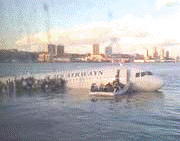Bird Strike Committee Proceedings
Date of this Version
8-2008
Document Type
Article
Abstract
UK aerodromes suffer consistently wet conditions that often result in standing water on airfield grassland or a requirement for water run-off and containment facilities. Such areas routinely present an attraction to hazardous birds including ducks, geese, waders and swans. Where possible, such features are eliminated from the aerodrome environment at the design stage or through the implementation of additional drainage. Practicalities and expense, however, can limit these options. This paper discusses the types of design features that are used to reduce the attraction of a wetland site to birds, and reports on the effectiveness of wiring, netting and bird balls as control systems for existing sites. Wire spacing needed to be reduced to 0.7 m intervals before a significant reduction in total bird numbers was achieved. 20 m spacing, however, was effective against swans. Netting, or wire spacing at less than 0.3 m was required to exclude all hazardous birds. Bird balls excluded all species but were not suitable for all sites. Continuous active deterrence patrols were successful at preventing the use of, but not investigation of, saturated wetland sites that developed during heavy rains on some airfields.



Comments
Abstract of paper presented at Bird Strike Committee USA/Canada Meeting, Lake Mary and Sanford, Florida, August 18–21, 2008.